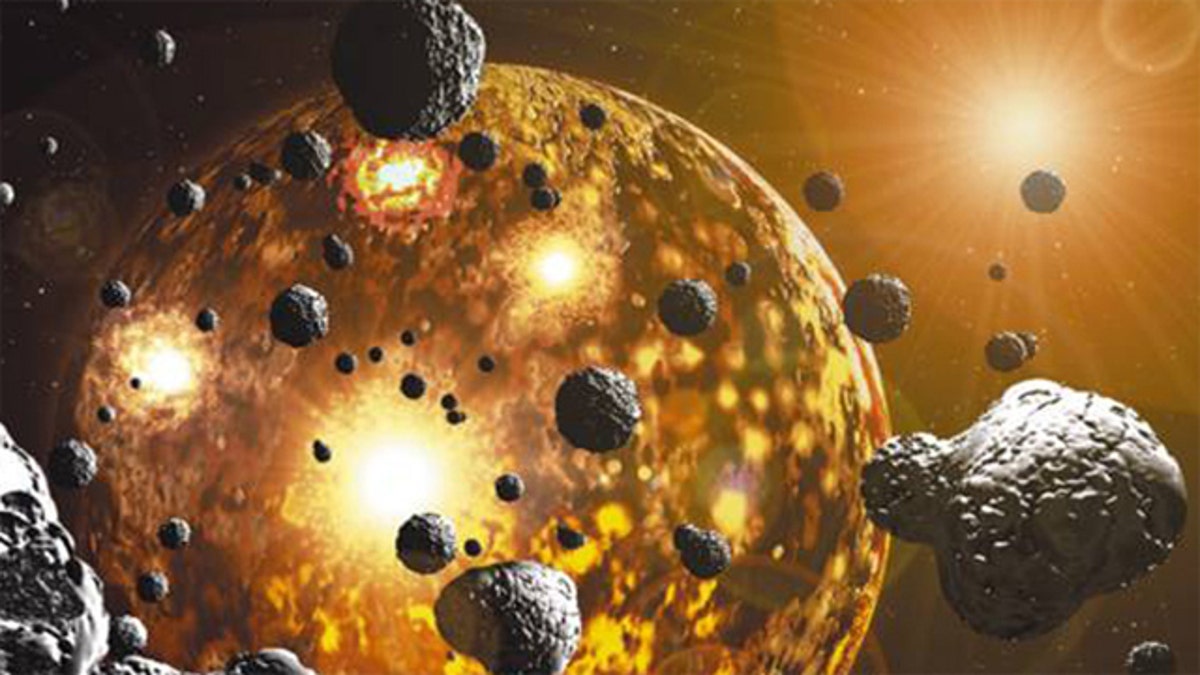
An artist's impression of the Earth during the period of meteorite bombardment 3.9 billion years ago. (Julian Baum/Take 27 Ltd)
Your wedding ring, the gold chain around your neck… even the platinum in your catalytic converter. For all of these you can thank a slew of meteorites that pelted Earth around 3.9 billion years ago, says new research.
Certain metals like gold, platinum, nickel, tungsten and iridium are attracted to iron, which comprises the Earth's core. So when the Earth first formed as a molten mass, all of these elements should have migrated to the core, leaving the outer layers of Earth stripped of its precious metals.
Yet as hopeful '49-ers knew, Earth's crust is laced with these enticing elements. Geologists have posed several theories to explain this puzzle, but one suggests that Earth was bombarded with meteorites between 3.8 and 4 billion years ago, studding the early crust with our favorite shiny metals. These metals then became incorporated into the modern mantle over time.
SCIENCE CHANNEL: See the Top 10 Meteorites
This idea is supported by the presence of craters on the moon, which date back to the same time, suggesting that the moon was also hit. Now, research published today in Nature, provides further evidence in favor of this explanation.
A team led by Matthias Willbold of the University of Bristol, U.K., sampled ancient rocks from southwest Greenland that formed some of the Earth's earliest crust, predating the proposed bombardment, and compared those with newer rocks from other places representing the modern mantle.
The researchers found distinct differences in the concentrations of particular tungsten isotopes in each type.
"This is a sort of a time capsule that gave us the possibility to calculate how much material had to be added to the Earth to satisfy the tungsten isotopic composition that we find in the Earth today," Willbold said.
"It is so far the best isotopic or geochemical evidence that late bombardment ever happened," he added.
"Our ability to measure these (isotopes) precisely enough to see these differences is just opening a totally new window into early planet formation," said Richard Carlson of the Carnegie Institution of Washington who has also studied early Earth using isotopes.
NEWS: Meteorites Carried Building Blocks to Earth
The researchers calculated that about half a percent of the present-day mantle would have been added by meteorites.
"That sounds like not really much, but it's about 300 billion billion tons of material," Willbold said.
"All the precious metals that we find today -- and probably also water -- have been introduced to the accessible Earth from these late stage meteorites," he said.
Indeed, the bombardment may even have brought the necessary conditions for life on Earth.
Carlson explained the early bombardment of meteorites would have been "a terrible event for life. It probably would have melted the planet, blown off any existing atmosphere."
But, he adds, "It's possible that this late veneer brought in the goodies afterward and it brought them in gently enough that they stuck around. I don't know that it brought in life, but it brought in maybe the constituents of it: the water, the right kind of surface temperatures, and the atmosphere that is conducive to life."




















